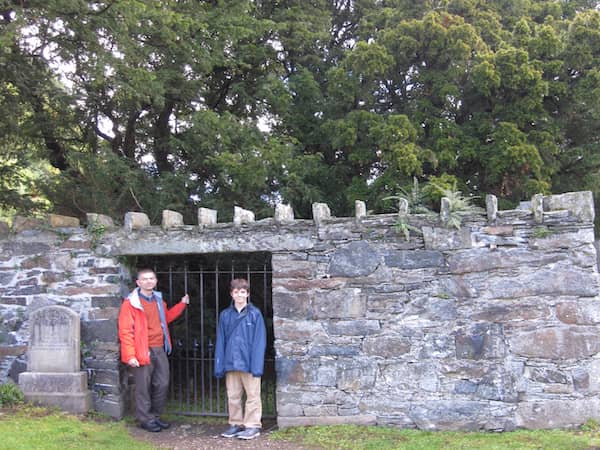Of Trees and Sex... er... Sex Change
| Gim Seung Hye | | Nov 06, 2015 03:09 AM EST |
(Photo : Max Coleman) Dr. Max Coleman visits the Fortingall Yew, an ancient tree that may have switched sex, Oct. 12, 2015.
A botanist thinks that an ancient tree in Scotland may have undergone a semi "sex change", indicating that humans are not the only living things plagued with gender-bender issues.
Dr. Max Coleman of the Royal Botanic Garden Edinburgh first spotted the possible "sex change" in the Fortingall Yew, a male coniferous tree that is estimated to have been around from 3,000 to 5,000 years.
Like Us on Facebook
He posted in his blog that the Fortingall Yew, which has not been known to be bi-sexual --they're traditionally either male or female but never both-- has sprouted red berries that are deemed female.
It might be that occasional switches of sex can maximize the reproduction potential, Dr. Coleman explained to a commenter on his blog, meaning the tree may have devised an evolutionary strategy to perpetuate its kind.
In Botany, flowering plants are either monoecious or dioecious. Monoecious plants bear separate male and female flowers on the same plant. Dioecious plants bear male flowers on one plant, and female flowers on another plant.
The Fortingall Yew, thought to be the oldest tree in the United Kingdom, belongs to the genus Taxus baccata and is classified as Dioecious. Yews traditionally bear male flowers on one tree, and female flowers on another, but this yew in question has now sprouted three female flowers on one branch.
A few horticulture enthusiasts have started to weigh in on the Scottish yew's alleged sex change.
"It could be that the tree has undergone a relatively common occurrence, which is to grow a new 'sport' that is morphologically different than its other parts. But that can not be technically considered a sex change," said one observer. Dr. Coleman thinks so, too.
"Odd as it may seem, yews, and many other conifers that have separate sexes, have been observed to switch sex. Normally this switch occurs on part of the crown rather than the entire tree changing sex. In the Fortingall Yew it seems that one small branch in the outer part of the crown has switched and now behaves as female," he blogged.
The shift in the tree's hormonal balance triggered by environmental stress may have caused the sex change in the Fortingall Yew, he explained to media.
The tree's questionable berries have been collected for analysis, and slated for inclusion in the Royal Botanic Garden Edinburgh's project to conserve the yew's diversity.
TagsTree Sex Change, Fortingall Yew, oldest tree in Europe, Max Coleman, Royal Botanic Garden Edinburgh, Scotland ancient trees, Yew hedge
©2015 Chinatopix All rights reserved. Do not reproduce without permission
EDITOR'S PICKS
-

Did the Trump administration just announce plans for a trade war with ‘hostile’ China and Russia?
-

US Senate passes Taiwan travel bill slammed by China
-

As Yan Sihong’s family grieves, here are other Chinese students who went missing abroad. Some have never been found
-

Beijing blasts Western critics who ‘smear China’ with the term sharp power
-

China Envoy Seeks to Defuse Tensions With U.S. as a Trade War Brews
-

Singapore's Deputy PM Provides Bitcoin Vote of Confidence Amid China's Blanket Bans
-

China warns investors over risks in overseas virtual currency trading
-

Chinese government most trustworthy: survey
-

Kashima Antlers On Course For Back-To-Back Titles
MOST POPULAR
LATEST NEWS
Zhou Yongkang: China's Former Security Chief Sentenced to Life in Prison

China's former Chief of the Ministry of Public Security, Zhou Yongkang, has been given a life sentence after he was found guilty of abusing his office, bribery and deliberately ... Full Article
TRENDING STORY

China Pork Prices Expected to Stabilize As The Supplies Recover

Elephone P9000 Smartphone is now on Sale on Amazon India

There's a Big Chance Cliffhangers Won't Still Be Resolved When Grey's Anatomy Season 13 Returns

Supreme Court Ruled on Samsung vs Apple Dispute for Patent Infringement

Microsoft Surface Pro 5 Rumors and Release Date: What is the Latest?










